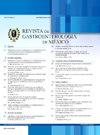Efecto de reunión trimestral y reporte por correo electrónico de TDA, tasa de intubación cecal y tiempo de retirada sobre medidas de calidad personales y de grupo en colonoscopia
IF 1.7
Q3 GASTROENTEROLOGY & HEPATOLOGY
引用次数: 0
Abstract
Introduction
Colonoscopy is the most utilized screening test for colorectal cancer (CRC). The adenoma detection rate (ADR), cecal intubation rate (CIR), and withdrawal time (WT) are established quality indicators (QIs) for colonoscopy. The aim was to measure the effect of individual and group QIs in colonoscopy by providing quarterly meetings and email feedback on ADR, CIR, and WT.
Material and methods
This is a prospective study in two steps. In the initial phase, we aimed to collect the QIs in colonoscopy from our division and in the second step, we aimed to assess the impact of a quarterly report. Pre-Intervention: Using electronic medical records (EMRs), an automated method for calculating the ADR was devised. ADRs from 6 months were obtained. Periodic Feedback: Endoscopists received quarterly feedback during staff meetings and emails for 9 months. Post-Intervention: QIs were recalculated for 8 months, and physicians did not receive reports.
Results
Over 23 months, 1,137 screening colonoscopies were conducted. Seven gastroenterologists participated, distributed into high (n = 6) and low (n = 1) detector groups. The mean patient age was 58.6 ± 9.2 years, with 659 (57.9%) females. Moderate sedation was used in 892 (78.4%) cases. QIs did not show significant improvement during the feedback or post-intervention periods compared with the pre-intervention period. Endoscopists initially categorized as «low detectors» exhibited the most substantial improvement, with the ADR increasing from 23.5% to 61.5% (P < .001).
Conclusion
Quarterly feedback and email reports did not significantly improve colonoscopy quality measures. Regarding the ADR, the intervention's impact was most prominent in «low detectors.»
季度AD会议和电子邮件报告对结肠镜检查个人和群体质量测量的影响、子宫颈插管率和恢复时间
结肠镜检查是结直肠癌(CRC)最常用的筛查方法。腺瘤检出率(ADR)、盲肠插管率(CIR)和停药时间(WT)是结肠镜检查的既定质量指标(QIs)。目的是通过提供季度会议和关于ADR、CIR和wt的电子邮件反馈来衡量个人和群体QIs在结肠镜检查中的效果。材料和方法这是一项分两步进行的前瞻性研究。在初始阶段,我们的目标是从我们的部门收集结肠镜检查的QIs,在第二步,我们的目标是评估季度报告的影响。干预前:利用电子病历(EMRs),设计了一种自动计算ADR的方法。获得6个月的adr。定期反馈:内镜医师每季度通过员工会议和电子邮件收到反馈,为期9个月。干预后:重新计算QIs 8个月,医生未收到报告。结果在23个月内,共进行了1137次结肠镜筛查。7名胃肠病学家参与,分为高检出率组(n = 6)和低检出率组(n = 1)。患者平均年龄58.6±9.2岁,女性659例(占57.9%)。892例(78.4%)患者使用中度镇静。与干预前相比,在反馈期间或干预后,QIs没有显示出显著的改善。最初被归类为“低检出率”的内窥镜医师表现出最显著的改善,ADR从23.5%增加到61.5% (P <;措施)。结论季度反馈和电子邮件报告并没有显著提高结肠镜检查质量指标。关于ADR,干预的影响在“低检测器”中最为突出
本文章由计算机程序翻译,如有差异,请以英文原文为准。
求助全文
约1分钟内获得全文
求助全文
来源期刊

Revista de Gastroenterologia de Mexico
GASTROENTEROLOGY & HEPATOLOGY-
CiteScore
1.60
自引率
12.50%
发文量
102
审稿时长
12 weeks
期刊介绍:
La Revista de Gastroenterología de México es el órgano oficial de la Asociación Mexicana de Gastroenterología. Sus espacios están abiertos a los miembros de la Asociación como a todo miembro de la comunidad médica que manifieste interés por utilizar este foro para publicar sus trabajos, cumpliendo con las políticas editoriales que a continuación se mencionan. El objetivo principal de la Revista de Gastroenterología de México, es publicar trabajos originales del amplio campo de la gastroenterología, así como proporcionar información actualizada y relevante para el área de la especialidad y áreas afines. Los trabajos científicos incluyen las áreas de Gastroenterología clínica, endoscópica, quirúrgica y pediátrica.
 求助内容:
求助内容: 应助结果提醒方式:
应助结果提醒方式:


